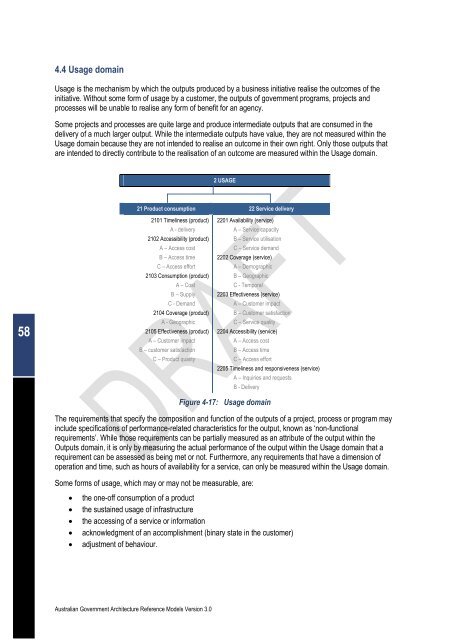Australian Government Architecture Reference Models Version 3.0
Australian Government Architecture Reference Models Version 3.0
Australian Government Architecture Reference Models Version 3.0
You also want an ePaper? Increase the reach of your titles
YUMPU automatically turns print PDFs into web optimized ePapers that Google loves.
58<br />
4.4 Usage domain<br />
Usage is the mechanism by which the outputs produced by a business initiative realise the outcomes of the<br />
initiative. Without some form of usage by a customer, the outputs of government programs, projects and<br />
processes will be unable to realise any form of benefit for an agency.<br />
Some projects and processes are quite large and produce intermediate outputs that are consumed in the<br />
delivery of a much larger output. While the intermediate outputs have value, they are not measured within the<br />
Usage domain because they are not intended to realise an outcome in their own right. Only those outputs that<br />
are intended to directly contribute to the realisation of an outcome are measured within the Usage domain.<br />
<strong>Australian</strong> <strong>Government</strong> <strong>Architecture</strong> <strong>Reference</strong> <strong>Models</strong> <strong>Version</strong> <strong>3.0</strong><br />
2 USAGE<br />
21 Product consumption 22 Service delivery<br />
2101 Timeliness (product)<br />
A - delivery<br />
2102 Accessibility (product)<br />
A – Access cost<br />
B – Access time<br />
C – Access effort<br />
2103 Consumption (product)<br />
A – Cost<br />
B – Supply<br />
C - Demand<br />
2104 Coverage (product)<br />
A - Geographic<br />
2105 Effectiveness (product)<br />
A – Customer impact<br />
B – customer satisfaction<br />
C – Product quality<br />
2201 Availability (service)<br />
A – Service capacity<br />
B – Service utilisation<br />
C – Service demand<br />
2202 Coverage (service)<br />
A – Demographic<br />
B – Geographic<br />
C - Temporal<br />
2203 Effectiveness (service)<br />
A – Customer impact<br />
B – Customer satisfaction<br />
C – Service quality<br />
2204 Accessibility (service)<br />
A – Access cost<br />
B – Access time<br />
C – Access effort<br />
2205 Timeliness and responsiveness (service)<br />
A – Inquiries and requests<br />
B - Delivery<br />
Figure 4-17: Usage domain<br />
The requirements that specify the composition and function of the outputs of a project, process or program may<br />
include specifications of performance-related characteristics for the output, known as ‘non-functional<br />
requirements’. While those requirements can be partially measured as an attribute of the output within the<br />
Outputs domain, it is only by measuring the actual performance of the output within the Usage domain that a<br />
requirement can be assessed as being met or not. Furthermore, any requirements that have a dimension of<br />
operation and time, such as hours of availability for a service, can only be measured within the Usage domain.<br />
Some forms of usage, which may or may not be measurable, are:<br />
� the one-off consumption of a product<br />
� the sustained usage of infrastructure<br />
� the accessing of a service or information<br />
� acknowledgment of an accomplishment (binary state in the customer)<br />
� adjustment of behaviour.

















